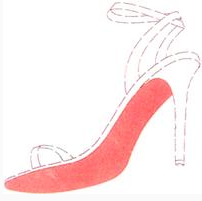Introduction & background
China trademark can be anything but straight forward as Christian Laboutin’s long pursuit of a China trademark illustrates. The trademark in question, a distinctive red sole on equally distinctive shoes for women is a stand out in the crowd point of difference.
The traverse through the China trademark regime began for Christian Laboutin when they sought, on April 15, 2010, to extend their existing mark to become a China trademark. They filed the following, seeking a China trademark with “high heeled shoes” as the goods designation. (Color may not be accurately represented).

China Trademark Office
The China Trademark Office (“CTO”) rejected the application in October 2010, finding that the trademark applied for was devoid of any distinctive character regarding the designated goods.
China Trademark Review and Adjudication Board
Undeterred, Christian Laboutin applied to the China Trademark Review and Adjudication Board (“TRAB” – consolidated into the National Intellectual Property Bureau in 2019) for review.
On January 22, 2015, the TRAB decided that the trademark applied for was a device mark consisting of the shape of one high-heel shoe with the bottom in a single color and inherently not distinctive.
The TRAB also held that the evidence provided to them did not prove that distinctiveness had been acquired by extensive use in commercial activity.
Beijing IP Court
Pressing on, Christian Laboutin filed a case with the Beijing IP Court. The case was accepted on June 12, 2015 (Chinese courts have a discretion whether to accept a case).
The Beijing IP Court delivered its judgement on December 20, 2017. It held that the China trademark applied for should be regarded as a 3D trademark, not a device. Accordingly, the case was referred back to the TRAB for them to consider whether the evidence was sufficient to establish the distinctiveness of this 3D trademark.
Beijing High Court
Christian Laboutin then appealed to the Beijing High Court. The case was accepted and the final decision was handed down on December 24, 2018.
The Beijing High Court decided that the China trademark under review was not a device mark or a 3D mark but a trademark made up of a single color used in a specific position – the sole of high heeled women’s shoes.
The Beijing High Court held that Article 8 of the China Trademark Law provides that any “signs” which can distinguish the commodities of a natural person, a legal person or other organisation from those of others can be used and registered as a trademark. The China trademark applied for by Christian Laboutin is within this definition.
The Beijing High Court accordingly requested the TRAB to reconsider the distinctiveness of the China trademark applied for based on the Beijing High Court’s findings of its true nature.
At the time of writing the TRAB has not made its decision.
Commentary
China Trade Mark Law – Article 8 and relevant part of Article 9
Article 8: Any signs, including words, graphs, letters, numbers,
three-dimensional symbols, color combinations, sound or any
combination thereof, that are capable of distinguishing the goods
of a natural person, legal person or other organization from
those of others may be applied for registration as trademarks.
Article 9: A trademark submitted for registration shall bear
noticeable characteristics and be readily distinguishable, and it
may not conflict with the legitimate rights obtained by others
earlier. …(WIPO translation).
Clearly, it has taken Christian Laboutin a very long time and a lot of money to legally establish the true nature of the China trademark applied for. It is not so clear, however, why it was so difficult to achieve this.
We have not seen the pleadings or the evidence in this case but the device mark and 3D findings do not seem to fit well with the practical reality of what has made shoes from Christian Laboutin stand out in use – the flash of red sole as the wearer stands, walks, and moves.
It is also not possible for us to know whether any limitations that might have been in the application were due to extending an existing mark as a China trademark as opposed to a direct China trademark application. Overall, we find that direct application usually leads to more predictable results.
China has been cautious in its approach to non traditional trademarks: sound, position, 3D, color and the like. They are quite difficult to register without demonstrable distinctiveness acquired by use in the China market place. It seems that the Beijing High Court has read “including” in Article 8 as “including but not limited to”. A very positive step in China’s trademark jurisptrudence.
Whether it is possible to register a China trademark of a type not specifically mentioned in Article 8 of the China Trademark Law has been long debated among China scholars and IP practitioners. The CTO has generally taken a very conservative approach. The decision of the Beijing High Court that a trademark type not specifically mentioned in Article 8 of the China Trade Mark Law can be registerable is welcome.
So far as we can ascertain, to date no single color trademark or position trademark has been approved for registration in China.
This decision of the Beijing High Court opens up the possibility of more scope for non traditional trade marks in China. It must be kept in mind, however, that China is not a case law jurisdiction and this decision provides guidance, not legal certainty.
The final decision of the TRAB is greatly anticipated by all parties, including the trademark practitioners in China. If the TRAB approves this trademark, it will be a big step in the development of the China trademark registration system with particular interest to those with non traditional trademarks.
There is also the nice legal issue of whether the TRAB will consider the distinctiveness in the market as of the date of the original China trademark application, the original TRAB review application, or now.
Wei Xin (Wei Xin currently chairs the INTA East Asia & Pacific NTM Sub-Committee)

